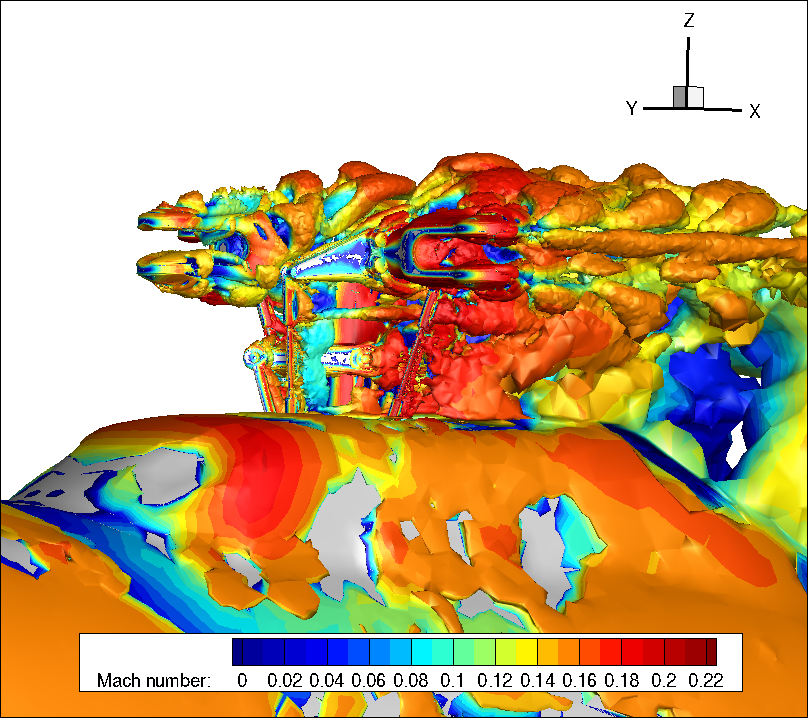Aerodynamic Analysis for High-speed rotorcraft
JAXA Supercomputer System Annual Report February 2023-January 2024
Report Number: R23EDA201C20
Subject Category: Aeronautical Technology
- Responsible Representative: Kanako, Yasue, Aviation Technology Directorate, Aircraft Lifecycle Innovation Hub
- Contact Information: Hideaki Sugawara(sugawara.hideaki@jaxa.jp)
- Members: Fumihiro Kajiwara, Yuki Kishi, Keita Kimura, Hideaki Sugawara, Ryo Takahashi, Yasutada Tanabe, Kanako Yasue
Abstract
Rotorcrafts have complex mechanisms around the main rotor and are exposed to non-streamlined shape parts, resulting in large aerodynamic drag. The aerodynamic drag of the hub accounts for 30% of the total drag of the helicopter. Reducing drag is expected to enable rotorcraft to achieve higher speeds. This work researches and develops devices to reduce rotorcraft drag, including around the hub.
Reference URL
N/A
Reasons and benefits of using JAXA Supercomputer System
Large-scale analysis is required to reproduce the complex geometry of rotorcraft, and analysis cannot be performed without the computational resources of a supercomputer.
Achievements of the Year
The aerodynamic drag of the helicopter is evaluated using the unstructured CFD code FaSTAR developed at JAXA. Prediction accuracy and changes in aerodynamic forces due to flowfield interference are investigated based on wind tunnel tests of a rotorcraft conducted in the JAXA 2m x 2m low-speed wind tunnel. The results of numerical simulations show good agreement with the wind tunnel test. It is found from the numerical simulation that the interference between the drag reduction device and the fuselage causes changes in the aerodynamic forces of the overall helicopter, providing important knowledge for the design of drag reduction devices.
Publications
– Non peer-reviewed papers
Higo, A., et. al, “A Study of Main Rotor Hub Drag Reduction Using CFD and Wind tunnel,” Aircraft symposium 2023.
Usage of JSS
Computational Information
- Process Parallelization Methods: MPI
- Thread Parallelization Methods: N/A
- Number of Processes: 10 – 20
- Elapsed Time per Case: 504 Hour(s)
JSS3 Resources Used
Fraction of Usage in Total Resources*1(%): 0.91
Details
Please refer to System Configuration of JSS3 for the system configuration and major specifications of JSS3.
| System Name | CPU Resources Used(Core x Hours) | Fraction of Usage*2(%) |
|---|---|---|
| TOKI-SORA | 9379316.15 | 0.42 |
| TOKI-ST | 4474456.48 | 4.83 |
| TOKI-GP | 0.00 | 0.00 |
| TOKI-XM | 0.00 | 0.00 |
| TOKI-LM | 74.68 | 0.01 |
| TOKI-TST | 0.00 | 0.00 |
| TOKI-TGP | 0.00 | 0.00 |
| TOKI-TLM | 0.00 | 0.00 |
| File System Name | Storage Assigned(GiB) | Fraction of Usage*2(%) |
|---|---|---|
| /home | 290.66 | 0.24 |
| /data and /data2 | 129332.74 | 0.80 |
| /ssd | 586.95 | 0.06 |
| Archiver Name | Storage Used(TiB) | Fraction of Usage*2(%) |
|---|---|---|
| J-SPACE | 7.19 | 0.03 |
*1: Fraction of Usage in Total Resources: Weighted average of three resource types (Computing, File System, and Archiver).
*2: Fraction of Usage:Percentage of usage relative to each resource used in one year.
ISV Software Licenses Used
| ISV Software Licenses Used(Hours) | Fraction of Usage*2(%) | |
|---|---|---|
| ISV Software Licenses(Total) | 42.01 | 0.02 |
*2: Fraction of Usage:Percentage of usage relative to each resource used in one year.
JAXA Supercomputer System Annual Report February 2023-January 2024



